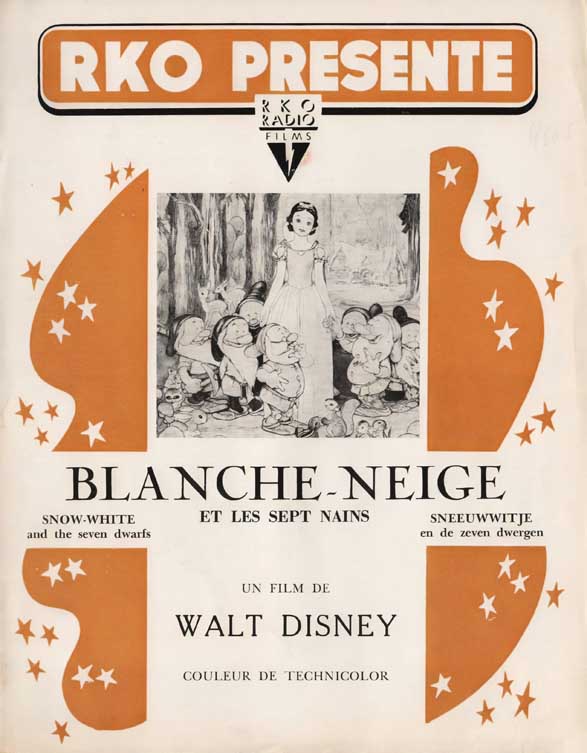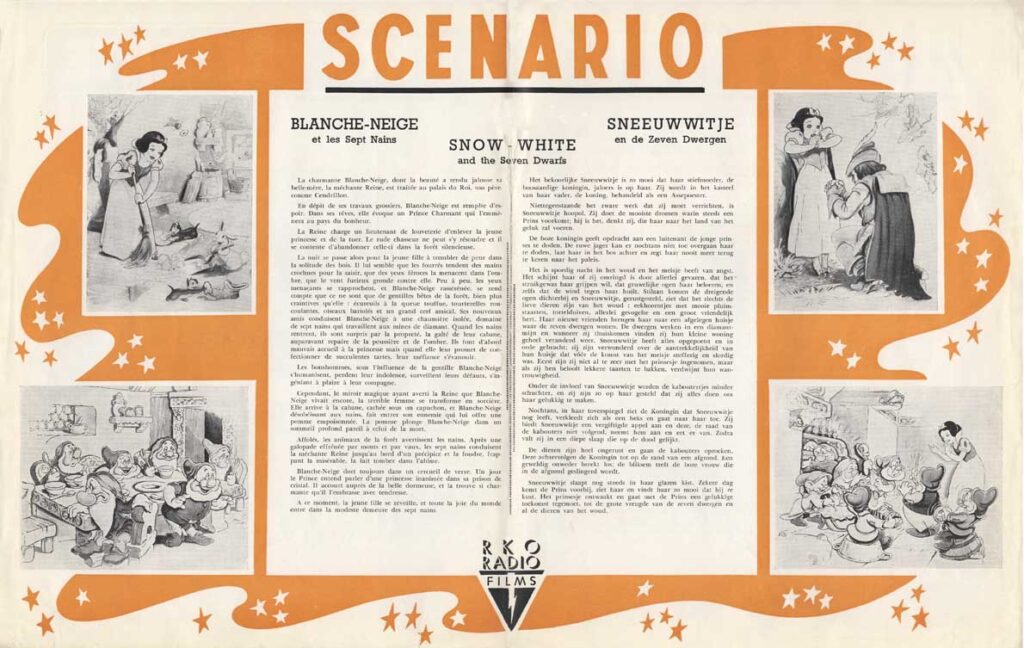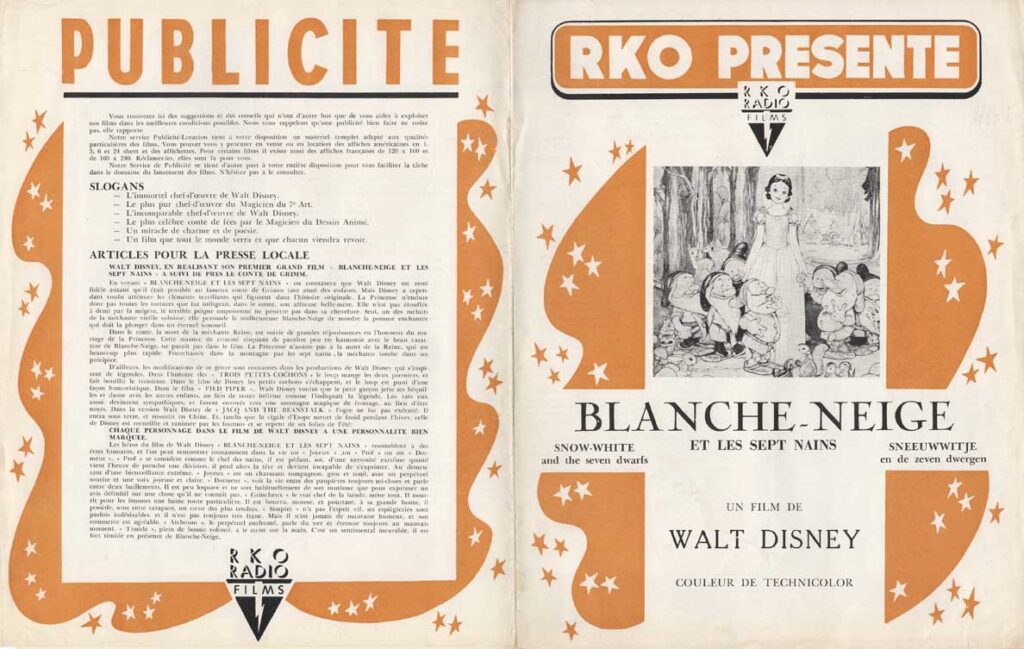Information
Complete title: RKO presents Walt Disney’s Snow White and the Seven Dwarfs
Author: unknown
Illustrations: Tom Wood & Gustaf Tenggren
Publication Date: August 1951
Country: Belgium
Dimensions: 8.66” x 11”
Number of pages: 4
Back to Campaign and Press books

This document was created in Belgium by RKO to help professionals such as journalists and exhibitors promote the film Snow White and the Seven Dwarfs when it was re-released in August 1951.
The inside of the document is a text telling the story of the film in French and Flemish, and the back cover details the advertising material available and gives examples of slogans to use and articles to reproduce in the local press.
The text is transcribed here:
Scenario
The lovely Snow White, whose beauty made her stepmother—the wicked Queen—jealous, is treated like a servant in the King’s palace, her father’s home, just like Cinderella.
Despite her harsh chores, Snow White is full of hope. In her dreams, she imagines a Charming Prince who will take her away to the land of happiness.
The Queen orders one of her huntsmen to take the young princess into the forest and kill her. The rugged hunter cannot bring himself to do it and instead abandons her in the silent woods.
That night, the young girl trembles with fear in the solitude of the forest. It seems to her that twisted branches are reaching out like claws to grab her, that fierce eyes are watching her from the shadows, and that the furious wind is roaring against her. Little by little, the threatening shapes draw closer, and a calmer Snow White realizes they are merely gentle forest animals, more frightened of her than she is of them: bushy-tailed squirrels, cooing doves, colorful birds, and a friendly stag.
Her new friends lead her to a secluded cottage, home to seven dwarfs who work in the diamond mines. When the dwarfs return, they are surprised by the cleanliness and cheerfulness of their cabin, once a dusty, gloomy place. At first, they react with suspicion toward the princess, but when she promises to bake delicious pies, their mistrust fades.
Under the kind influence of Snow White, the little men become more human, lose their laziness, watch their flaws, and do their best to please their new companion.
Meanwhile, the magic mirror informs the Queen that Snow White is still alive. The terrible woman transforms herself into a witch. She makes her way to the cottage, cloaked and disguised, and Snow White—disobeying the dwarfs—lets the stranger inside. The old woman offers her a poisoned apple. One bite sends Snow White into a deep sleep, like death itself.
Panicked, the forest animals alert the dwarfs. After a frantic chase over hills and valleys, the seven dwarfs corner the wicked Queen at the edge of a cliff, where lightning strikes her and sends her plunging into the abyss.
Snow White still sleeps in a glass coffin. One day, a Prince hears of a beautiful princess lying lifeless in a crystal tomb. He rushes to her side and finds her so enchanting that he kisses her tenderly.
At that moment, the young girl awakens, and all the joy in the world fills the humble home of the seven dwarfs.


Advertising
You’ll find here suggestions and advice intended to help you promote our films under the best possible conditions. Let us remind you that good advertising doesn’t cost—it pays.
Our Advertising and Distribution Service offers you a full range of promotional materials tailored to the specific qualities of each film. You can purchase or rent American posters in 1, 3, 6, and 24-sheet formats, as well as lobby cards. For certain films, there are also French posters available in 47″ x 63″ and 63″ x 94″ formats. Be sure to ask for them—they’re available for your use.
Our Advertising Department is also entirely at your disposal to assist you in the promotional launch of your film. Don’t hesitate to consult them.
Slogans
- The immortal masterpiece by Walt Disney
- The purest masterpiece from the Wizard of the Seventh Art
- The incomparable work of Walt Disney
- The most famous fairy tale by the Wizard of Animated Cartoons
- A miracle of charm and poetry
- A film everyone will see and want to see again
Articles for the local press
WALT DISNEY, IN CREATING HIS FIRST FULL-LENGTH FEATURE FILM “SNOW WHITE AND THE SEVEN DWARFS,” REMAINED TRUE TO THE GRIMM FAIRY TALE.
Watching Snow White and the Seven Dwarfs, one will see that Walt Disney stayed as true as possible to the beloved Grimm Brothers’ tale. Still, he chose to soften some of the more terrifying elements in the original story.
The Princess doesn’t endure all the cruel torments inflicted by her evil stepmother in the tale. She isn’t suffocated by the bodice, nor does the poisoned comb pierce her scalp. Only one of the old witch’s evil deeds remains: she tricks poor Snow White into biting the enchanted apple that plunges her into eternal sleep.
In the original story, the Queen’s death is followed by great celebrations in honor of the Princess’s wedding. This touch of cruelty, which might seem at odds with Snow White’s gentle character, was omitted from the film. The Princess doesn’t witness the Queen’s death, which happens much more quickly. Chased into the mountains by the seven dwarfs, the evil woman falls into a ravine. These kinds of modifications are common in Walt Disney’s adaptations of traditional legends.
In The Three Little Pigs, the wolf eats the first two and boils the third. But in Disney’s version, the pigs escape, and the wolf is humorously punished.
In The Pied Piper, Disney lets the little boy throw away his crutches and dance with the other children, rather than remaining crippled as in the original tale. The rats also become sympathetic and are sent to a magical mountain of cheese instead of being drowned.
In Disney’s version of Jack and the Beanstalk, the giant isn’t killed; he dives underground and emerges in China. And while Aesop’s grasshopper dies of cold in winter, Disney’s version is taken in and revived by the ants, who forgive her for her summer folly.
EVERY CHARACTER IN WALT DISNEY’S FILM HAS A DISTINCT PERSONALITY
The heroes of Walt Disney’s Snow White and the Seven Dwarfs are all modeled after real-life types. You might easily come across someone in real life who resembles “Happy,” “Doc,” or “Sleepy.” “Doc” thinks of himself as the leader of the group. He’s pedantic, a bit dim-witted, and extremely nervous when decisions need to be made—so much so that he loses his train of thought and becomes tongue-tied. Still, he’s full of goodwill.
“Happy” is a charming, round, cheerful fellow with a bright, joyful voice and a constant smile.
“Sleepy” sees the world through half-closed eyelids and speaks between yawns. He’s a man of few words and only speaks when he has something final to say—usually about something he doesn’t actually know.
“Grumpy,” the real boss, takes charge of everything. He harbors a special hatred for women. He’s gruff and gloomy, yet to his great shame, he has one of the softest hearts of all.
“Dopey” isn’t the brightest, and his antics can sometimes be unwelcome. He’s not always very truthful, but he’s never in a bad mood and is a pleasant companion.
“Sneezy,” always sniffling, speaks through a stuffy nose and tends to sneeze at the worst possible moment.
“Bashful,” full of goodwill, wears his heart on his sleeve. He’s an incurable romantic and terribly shy around Snow White.
